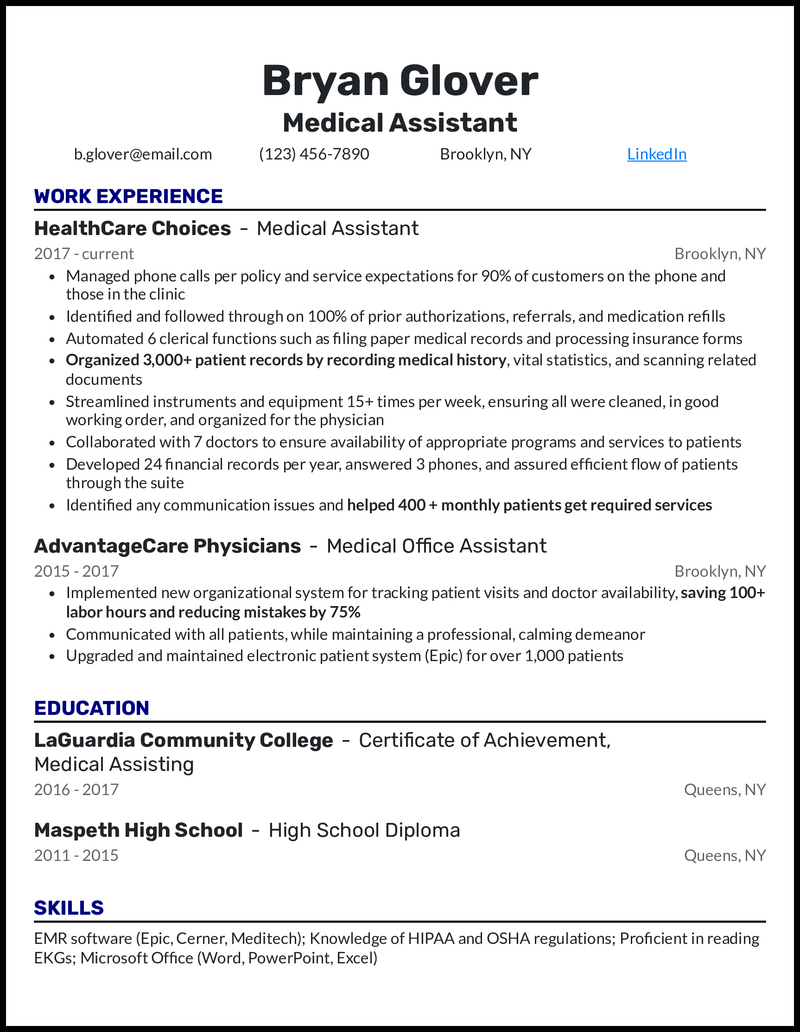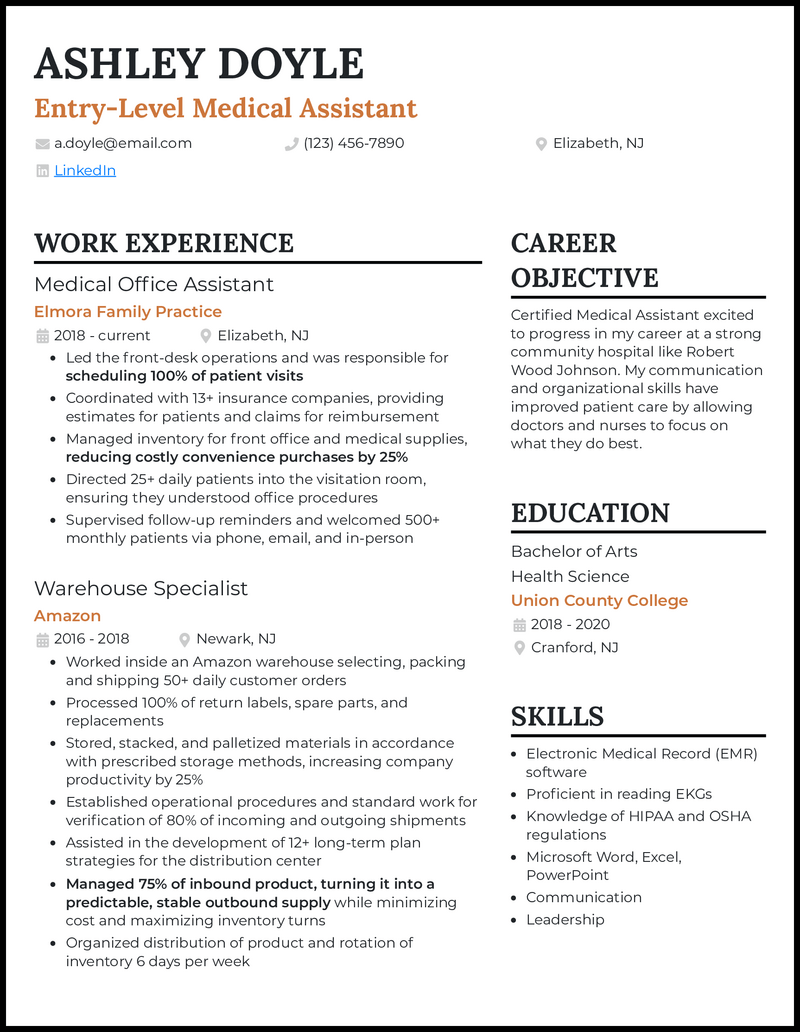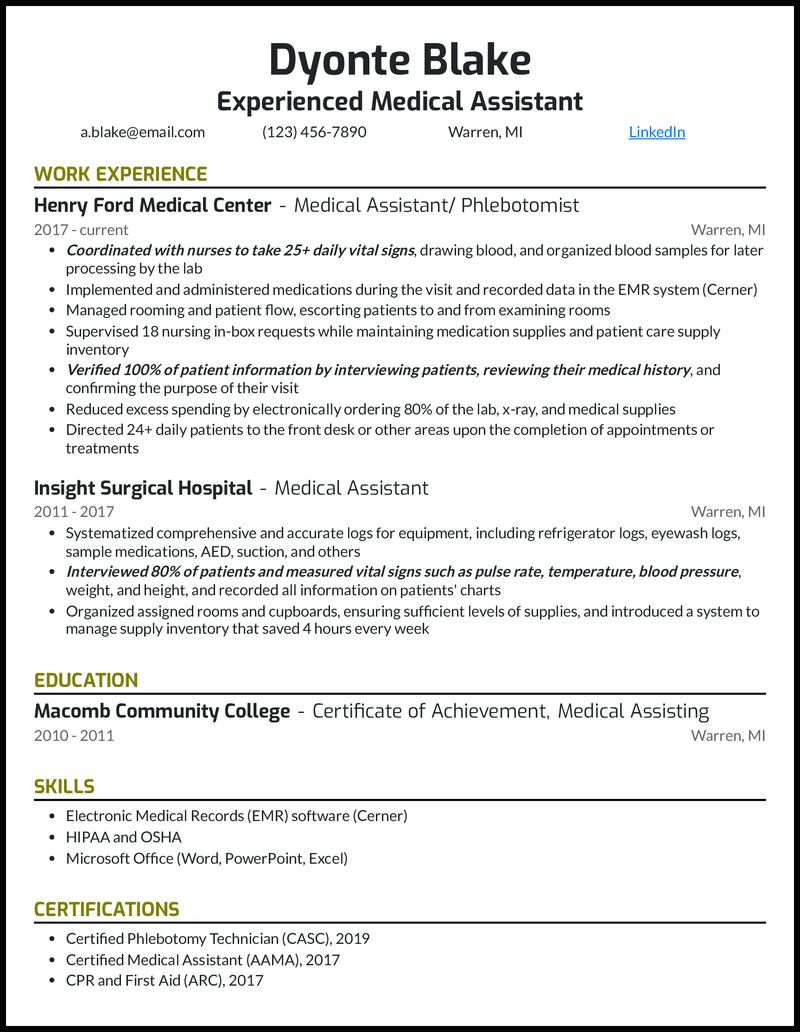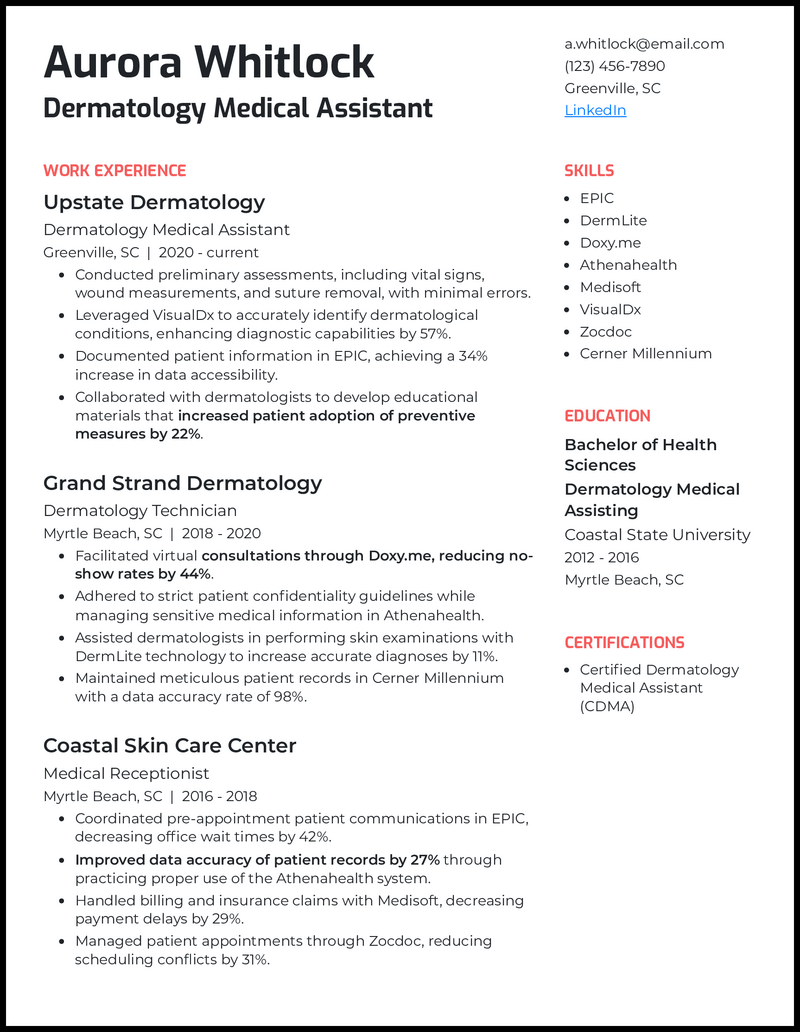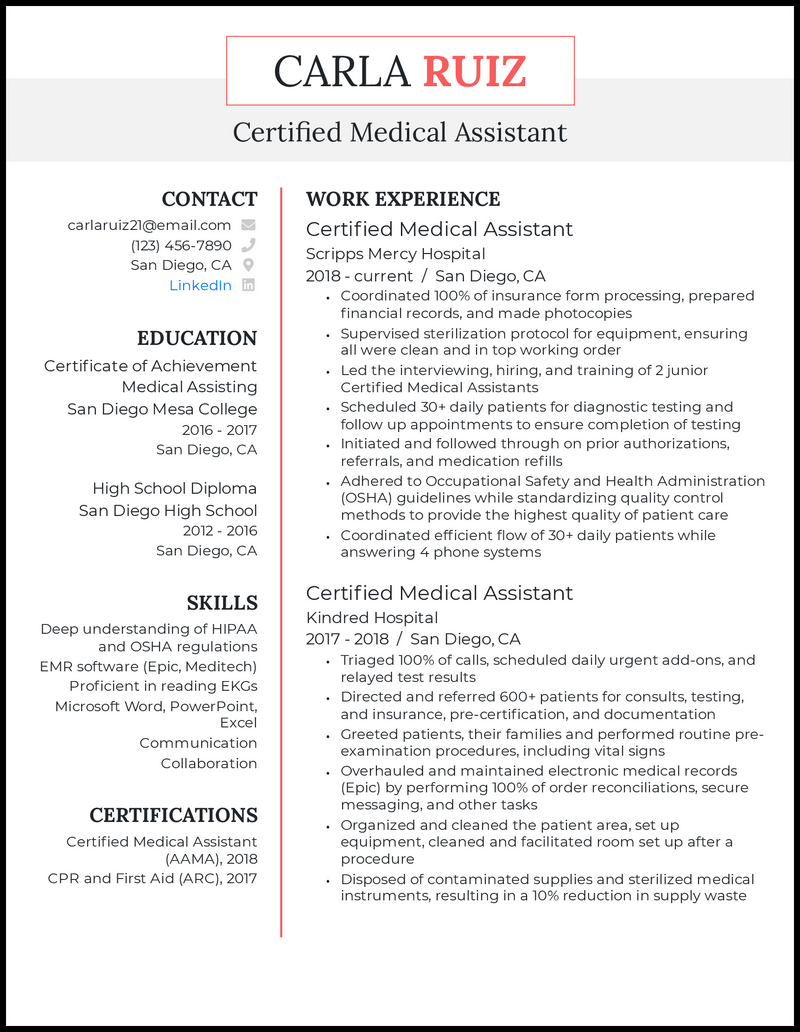Medical assistant jobs are in high demand. The field is expected to grow by 24 percent through 2025, much higher than the average for most other jobs.
You know your way around EMR systems and how to deliver an excellent experience to patients. You shouldn’t also need to be an expert at writing a resume. It can be challenging to discuss your experience and qualifications correctly on your resume.
Our medical assistant resume examples have helped medical assistants land jobs at great hospitals and physician’s offices around the country, so they’re the perfect place for you to get started.
Why this resume works
- If you include a resume objective, customize it for each job you apply to by matching the keywords mentioned in the job.
- Most medical assistant jobs require you to be certified. Generally speaking, these certifications need to be renewed every five years, so make sure you include the year you were last certified.
- Many different organizations grant medical assistant certifications. Standards vary by hospital and state, so be clear and include the body that certified you.
- Similarly, CPR and First Aid certifications generally last for two years. Remember to include the year you were last certified, or a potential employer might question if your certification is current.
Why this resume works
- As a young professional looking to break into the medical field, it helps to highlight volunteer experiences that speak to your abilities.
- Projects that leveraged your competency with medical software, such as a public health fair, can be just as valuable on your medical assistant student resume as a full-time healthcare position.
Why this resume works
- For a medical assistant externship resume, aim higher than just expressing your eagerness to learn. After all, other college students seeking an externship opportunity want to learn, too. Leapfrog the competition with real-world success.
- Can you recount presenting a relevant project at college? Or maybe you attended a seminar like “TechNurse Evolution” in Mia’s piece? Be sure to bring these moments to life in your resume and then you can fill in the details in your medical assistant cover letter. You’ll need this extra flair besides your appetite for knowledge to learn to make a lasting impression on the hiring manager.
Why this resume works
- Landing your first job as a certified medical assistant can seem daunting. However, a huge plus is a commonly accepted certification process. So once you get your certification, the process becomes far more straightforward.
- Your entry-level medical assistant resume could be solid if you had related experience in medicine before earning your certification. If you lack experience, contact medical offices in your area to see if they need organizational help.
- When outlining your resume, it’s perfectly okay to include previous work experience outside of medicine. This can help show that you’re disciplined and organized.
Why this resume works
- Phlebotomy is drawing blood (more commonly known as a blood draw). It requires a separate certification, but it’s not uncommon for experienced medical assistants to specialize as it increases responsibilities on the job and can lead to an increase in pay.
- Your resume skills section should not be exhaustive but include the essential skills mentioned in the job description. For medical assistants, it’s common to list familiarity with OSHA and HIPAA standards, plus anything else that might set you apart.
- You can include a wide range of skills, from interpersonal (like interviewing patients) to technical (like updating patient records). Remember to highlight the breadth of your expertise whenever possible on your experienced medical assistant resume.
Why this resume works
- Make it a mission to tailor your lead medical assistant resume to the job description. This strategy goes beyond eluding the applicant tracking system’s scrutiny. You transform from a name on a page to an able candidate who took the time to understand the potential employer’s needs.
- Is Asana listed as a crucial tool? Show how you used it previously for team collaboration. Do they dictate proficiency in the SurgiCare Inventory? Detail how you used the platform to streamline medical supplies’ storage, tracking, and usage.
Why this resume works
- Chances are pretty high that the organization you’re applying to will use an applicant tracking system (ATS) to sift through incoming pediatric medical assistant resumes. The game plan? Stay ahead of the game by optimizing your piece for the ATS.
- First things first, examine the job ad carefully and single out relevant keywords. Got them? Then, sprinkle them around your resume. In addition, opt for a layout that the ATS can easily read—this means avoiding any graphics or images that could potentially throw a wrench in your job-hunting efforts right from the start
Why this resume works
- So, you’ve put in the work, polishing your resume so it does a stellar job of showcasing you as a competent clinical medical assistant. But your phone is yet to ring. And there you are, ready and waiting, but your phone? Silent as a mime. Heads-up: it might be your choice of contact details rubbing recruiters the wrong way.
- Listen, your updated phone number and email are the bare minimum. Plus, you bag bonus points with a professional email address like t.adams@email.com. So, perhaps save wacky stuff that might raise eyebrows or snag a laugh (think “cat_lover@…com” or love_skeptic@…com”) for the group chats with friends, not your clinical medical assistant resume.
Why this resume works
- Supporting dermatologists as a medical assistant requires specialized knowledge of technology used exclusively for skin procedures.
- Include examples of your work with tools such as DermLite on your dermatology medical assistant resume to emphasize your field-specific skill set.
Why this resume works
- It’s okay to show a little personality in your medical administrative assistant resume. This is true, especially if those activities demonstrate leadership.
- If you have resume-related hobbies and interests that stand out, include them when you’re a bit light on relevant work experience.
- When discussing your work experience, it helps to start each bullet point with a strong action verb. Format your resume so that it’s easier to scan (the average recruiter spends less than 24 seconds reviewing a resume), and make it clear that you’ve had an impact in previous roles.
Why this resume works
- In addition to a certification, most medical assistant jobs require finishing high school (or earning your GED). If you don’t have college experience, it’s okay to include high school in the “Education” section of your certified medical assistant resume.
- As you gain more experience as a medical assistant, you should show more leadership and impact. You can beef up your resume by touching upon organizational systems (such as inventory and patient scheduling) that save time and reduce the chances of making mistakes.
- Colleges around the country offer specialized programs to train you to become a medical assistant. They’re generally two semesters long, can be part-time, and ultimately end with a certification. If you attended one of these programs, then absolutely mention it.
Related resume guides
Resume Format for a Medical Assistant

Aside from the actual content of your resume, the formatting you use determines whether a hiring manager will seriously consider your medical assistant resume. When formatted correctly, your resume will be easy to read, have a logical flow, and be complete.
If your resume lacks these formatting qualities, there’s a likelihood that hiring managers won’t take your resume seriously; if it makes their job more difficult, they may toss your application. To properly format your resume, you’ll want to pay special attention to the following:
- Resume format options
- Contact info and header
- ATS and readability

Resume format options
You have a few resume formats to choose from, with these being the most popular in 2025:
- Reverse-chronological: This type of format is uniquely positioned to highlight your most recent job experience first, highlighting career growth and giving a competitive advantage when numerous applicants compete with you for the same position.
- Functional: This resume format highlights skills over work experience. You might choose this format if you have large gaps in your work experience, but be cautious because many recruiters may find this format confusing or less forthcoming than other popular formatting options.
- Combination/hybrid: The combination/hybrid format blends both reverse-chronological and functional formatting by skills and work experience with equal weight. It’s a popular choice for industry experts with many years of experience.
Each type of format can be considered for your resume, but reverse-chronological formatting is what we tend to recommend for any medical assistant resume.
Since recruiters in the medical industry are routinely inundated with 100+ resumes per job posting, they prefer resume formats that lend themselves to quick skimming. A reverse-chronological resume does that while highlighting your most recent job title.

Contact info and header
When a recruiter determines that they want to reach out for an interview, make sure they know how to reach you. Using a large font, position your name on the left side or top center of your resume, and use a smaller font to include the medical assistant job title you seek. Have your contact info available, too.
Your resume header should consist of:
- Name
- Job title you’re seeking
- Phone number
- City/State (optional)
- Professional links (such as LinkedIn or other professional sites) (optional)
Your header is also a good place to add a (professional) pop of color. Take a look at these resume examples and the visual sample below to get inspiration for a wide variety of header styles!


ATS and readability
We don’t want to sound dramatic, but we can’t overemphasize how important it is that your medical assistant resume is ATS-friendly for every job you apply to in 2025.
What is ATS? Simply put, Applicant Tracking System software (ATS) became an integral part of the recruitment process after the explosion of the internet led to sharp increases in online job applicants.
ATS will scan your resume, searching for keywords by recognizing your resume formatting. For this reason, it’s critical that your medical assistant resume matches ATS standards, lest your application gets thrown out without ever being reviewed.
Beat the ATS with these tips:
- Margins: Margins on all sides of your resume should be between 0.5-1.0 inch.
- Fonts: Stick with basics like Arial, Calibri, Cambria, or Times New Roman.
- Font sizes: Your name should be the largest font size (around 24-point), with your title slightly smaller (around 20-point). The rest of your resume (including your contact information) should remain at the standard font size of 12-point.
- Header names: Headers throughout your text should stand out in some way. Consider using bold text or contrasting colors.
- Skills: Read the job posting. Highlight skills that are particularly applicable for every medical assistant job to which you’re applying.
- Logical order: As mentioned, we recommend using reverse-chronological order, with your most recent job experience at the top of the page. ATS prefers it, and it’s easier to read.
- One page: If your resume is over a page, it’ll look strange, and recruiters will wonder if you lack enough experience.
Feeling overwhelmed? Check out our resume builder to ensure your formatting is done correctly.
Resume Writing for a Medical Assistant

Job hunting is stress-inducing for most people, and many think of resume and cover letter writing as the peak of their anxiety.
Thankfully, writing an effective resume doesn’t have to be overwhelming. The key is to take it one section at a time. Using our resume builder, you can avoid all the frustration of writing and re-writing improperly formatted sections. Save yourself the time that could be spent on the job search. Let’s address the essentials:
- What’s the objective/summary all about?
- Work experience
- Top skills for your medical assistant resume
- Education, certs, projects, interests, and hobbies
- Resume customization for every medical assistant job application
- Edit for a flawless medical assistant resume

What’s the objective/summary all about?
Though similar in many ways, a resume objective and summary statement are slightly different paragraphs to consider including in your medical assistant resume. Both are highly specified, short (two to three sentence) paragraphs, but an objective will emphasize why you’re seeking the job, whereas a summary highlights the skills you’ve honed throughout your career.
Consider including a resume objective if you’re going through a substantial career change, such as a dental assistant to a surgical assistant. An objective can also be a helpful place to emphasize why you’re seeking a particular role (and use up white space) if you have minimal experience.
On the other hand, resume summaries focus on skills and specializations developed throughout your career. Consider adding a resume summary if you’re a seasoned medical assistant with 10+ years of experience.
If you decide to include a resume summary or objective, you’ll need to commit to customizing it for every job to which you apply. Let’s review some great examples of highly-specialized resume summaries and objectives.

Example 1—A poorly written objective:
Want to improve my career prospects with a job that will get me experience in the medical field.
What we don’t like: This objective contains no specific details. It should include the job title you’re seeking, one to three specific skills that will help you contribute to the work environment, and the business name to which you’re applying. This objective consumes precious space on your resume without providing any useful information.
Example 2—A strong resume objective:
OSHA and HIPAA-compliant medical assistant with 6+ years of proven experience serving 100+ daily patients in fast-paced ER environments. Seeking an opportunity at Trinity United Healthcare to continue serving patients and medical staff in the Pediatric Orthopedics department, where my efficient workflow and compassionate care management can help ensure more patients are served per hour.
What we like: Specific skills, years of experience, job title, hospital name, and work contributions were mentioned. A resume objective like the one above and the visual sample below deserve the space they take up on your resume.


Example 3—A poorly worded summary:
I have years of experience working well as a medical assistant.
What we don’t like: Like the first objective example, this summary provides little substance. It’s vague and short.
Example 4—A strong resume summary:
Detail-oriented medical assistant with 20+ years of experience in clinics and hospitals across Idaho, with a depth of knowledge of HIPAA, ERM software, medical terminology, and Microsoft Office. I enjoy working in fast-paced environments that enable me to improve patient comfort, physician efficiency, and operating systems.
What we like: This summary gets right to the point, discussing some of the most valuable skills a great medical assistant will possess while highlighting years of work experience and how they would add value to the business.

Work experience
Your work experience section should include two to four positions you’ve had throughout your career. That means, if you’ve been a medical assistant for many years, you don’t need to include information about the job you had in high school. Instead, focus on the most recent 10-year period, and narrow that list to the most relevant.
Note: if you’ve just entered the workforce, there’s nothing wrong with highlighting less relevant job experience or even class projects and volunteer experience, but we’ll touch on that later.

Writing your job description bullet points
Chunking your job description text with bullet points is a great way to enhance readability and reduce a visually dense or overwhelming resume.
While writing bullet points, focus on:
- Action verbs: Start each bullet point with strong, unique verbs such as “Outperformed” or “Overhauled.”
- Active voice: Avoid passive voice. A passive phrase, like “the IV was inserted by the R.N.,” is less interesting than active language, like “the R.N. inserted the IV.”
- Avoid personal pronouns: The employer knows your resume is written about you!
- Either using punctuation or not: When you start writing your bullet points, you can leave periods at the end of your sentences or skip them. Whatever you choose, be consistent.
- Verb tense: Though you can keep your current experience in the past tense, ensure all your past work experience is written in the past tense.
Here are a few medical assistant bullet points that incorporate this advice:
- Overhauled clinic software operations, integrating Meditech EMR to boost office operation efficiency.
- Initiated HIPAA-compliant integration into Microsoft Office scheduling systems.
- Outperformed efficiency targets, reaching more clients to confirm appointments and follow up on visits than any other M.A.
We like these bullet points because they use active voice and action words while avoiding personal pronouns such as “I” or “my,” and they have consistent punctuation written in the past tense.

Quantify your medical assistant impact
The only thing our above bullet point examples are missing is quantifiable metrics (numbers). Numbers are an essential element in your medical assistant resume, and you should aim for at least 50 percent of your bullet points, including them.
Why are metrics important?
Numbers positively impact your resume in two ways. First, the visual interest helps break up text and draw in hiring managers’ eyes. This is critical, as it will encourage them to read your resume more thoroughly. Second, numbers are impressive because they demonstrate your proven job performance. In the context of your medical assistant resume, numbers say a thousand words.
Here are a few places you can leverage metrics from your medical assistant work experience:
- Patient volume
- Consider highlighting your organizational skills by noting the number of patient records you’ve organized. You may also wish to discuss the number of patients you call per shift, the size of the hospital you work for (volume of patients, number of physicians, etc.), or the percentage of patients who gave you positive reviews.
- Increased operations efficiency
- Highlight how you’ve improved workflow as a medical assistant. Perhaps that means you’ve provided hundreds of appointment confirmations, reducing gaps in physician schedules? Or maybe you reorganized E.M.R. software, resulting in increased capacity for patients?
- Administration
- Including metrics about your administrative duties isn’t too hard. Think about the percentage of total office insurance forms you processed, the number of appointments you’ve scheduled per shift, referrals you’ve written, or the types of electronic medical records software you’re trained to use.
Here are a few examples of job description bullet points that would work well for any medical assistant resume.
- Automated 6 clerical functions, including processing insurance forms and filing medical records
- Scheduled 30+ daily patients for diagnostic testing and follow-up appointments to ensure completion of testing
- Overhauled and maintained EMR by performing 100% of order reconciliations, secure messaging, and other tasks

Top skills for your medical assistant resume
One of the most under-utilized sections on most resumes is the skills section. Many medical assistants don’t realize that this section is essential for catching the eye of ATS. Since ATS works by matching keywords in your resume to pre-selected words (skills) chosen by hiring managers, you want to ensure you’re listing the right skills.
Ideally, your medical assistant resume should include both hard and soft skills. Hard skills such as “CRM software proficiency” can be trained. They’re highly specific to the job title you’re seeking, and they demonstrate your ability to utilize the skill (they’re easily measurable).
On the other hand, soft skills are skills you can include on any resume. These skills, such as “organization” or “attention to detail,” are universally important. However, it’s difficult to measure these skills; they’re often overused and may be disregarded by hiring managers.
Focus mostly on hard skills while incorporating a few particularly relevant soft skills. Include 6 to 10 resume-relevant skills for your medical assistant resume, such as:
- Infectious Disease Mitigation and HIPAA compliance: Being aware of regulations, laws, and best practices to keep patient information safe while reducing the risk of contracting or spreading disease. Hiring managers won’t overlook these hard skills.
- Reading electrocardiograms (EKG): This is a great hard skill that not all medical assistants have. Stand out by emphasizing your vitals-taking skills.
- EMR software: Do you have an understanding of Epic or Meditech software? Specify which EMR systems you know.
- Typing speed: If you want to impress, use this hard skill and share your words per minute.
- Bilingual: Do you know Spanish, A.S.L., or Arabic? Share this hard skill, as it’s always in high demand in healthcare.
- Compassionate care: This is a soft skill, but it’s important that the focus of all of your work as a medical assistant is on the health and well-being of your patients.

Education, certs, projects, interests, and hobbies
Becoming a medical assistant has a few different educational routes. Some employers are satisfied with on-the-job training experience, while others seek applicants with one-year certificates or an associate’s degree. Legally, there are no formal training requirements to become a medical assistant.
When listing your education, avoid including too many details unless you’re a recent graduate with limited work experience. As you gain work experience, you can reduce details about your education, including only your most advanced education level.
Though not required by all employers, most prefer CPR and First Aid Certification; if you have your Certified Medical Assistant Certification (AAMA), include it. Like Certified Phlebotomy Technician (CASC), other specialized certifications will make your resume even more impressive.
Wow employers with your most impressive certs.
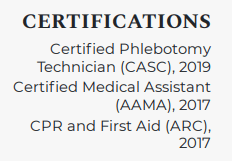
You may wonder if you should include resume-related interests and hobbies in your piece. Generally, we don’t recommend medical assistants have these on their resumes, but there are instances it may be appropriate:
- Anyone with minimal work experience should consider adding interests and hobbies.
- If you’ve just graduated from high school or finished your AAMA certification program, you might include interests and hobbies to prove that you would thrive in a medical assistant position.
- Just make sure you elaborate on how the hobby or interest is relevant during an interview!
- If you have any relevant volunteer experience, this is a great place to discuss it.
- Perhaps you’ve spent years volunteering for a non-profit that sorts and ships medical equipment around the world? Or maybe you volunteer with the administrative office at your local hospital?

Resume customization for every medical assistant job app
Want to stand out from the competition? Then make sure the employer sees that you read the job description, that you take their time seriously, and that you genuinely want this position.
Show you care by customizing your resume to every job you apply for.
- If you include a resume objective or summary, tailor it to the job—mention specifics like the job title, relevant skills, and the company name.
- Your skills section should be fully customized. Read the job description to determine which skills are essential to the hiring manager.
- Your bullet points should also be specialized. Again, focus on what the job description says, and write your bullet points to highlight your most closely-aligning experience.

Edit for a flawless medical assistant resume
Finally completed your resume? Step back from your masterpiece and come back with fresh eyes for the edits. Once you return to it, you may be surprised that a few grammatical errors made it prominently onto your resume.

Get Hired
Wahoo, cheers to you! You’ve taken the first step to upping your resume game. We’ve covered many topics, including formatting techniques, ATS, skills section, work experience tips, and more. We know you’re ready for the next step:
- Tap into our resume checker to upload your existing medical assistant resume. Once there, you’ll get AI-powered tips to improve things like verb tense, work experience, word counts (per bullet point and resume), and your use of action words.
- Don’t have a resume yet or want to start from scratch? Check out our AI resume builder, which allows you to build a brand-new piece using AI-powered tips.





